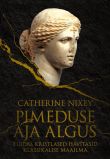What do you think?
Rate this book


320 pages
First published September 1, 2017

“It has been estimated that less than 10% of all classical literature has survived into the modern era. For Latin, the figure is even worse: it is estimated the only 1/100 of all Latin literature remains. If this was ‘preservation’—as it is often claimed to be—then it was astonishingly incompetent. If it was censorship, it was brilliantly effective. The ebullient, argumentative classical world was, quite literally, being erased.”
As soon as she stood on the street, the parabalani, under the guidance of a Church magistrate called Peter – ‘a perfect believer in all respects in Jesus Christ’ – surged round and seized ‘the pagan woman’. They then dragged Alexandria’s greatest living mathematician through the streets to a church. Once inside, they ripped the clothes from her body then, using broken pieces of pottery as blades, flayed her skin from her flesh. Some say that, while she still gasped for breath, they gouged out her eyes. Once she was dead, they tore her body into pieces and threw what was left of the ‘luminous child of reason’ onto a pyre and burned her.
It is now thought that fewer than ten martyrdom tales from the early Church can be considered reliable. The martyr stories, inspiring and entertaining though they may be, show what the scholar G. E. M. De Ste. Croix called ‘an increasing contempt for historicity’.
It was this law that caused the Academy to close. It was this law that led the English scholar Edward Gibbon to declare that the entirety of the barbarian invasions had been less damaging to Athenian philosophy than Christianity was. This law’s consequences were described more simply by later historians. It was from this moment, they said, that a Dark Age began to descend upon Europe.
This is a book about the Christian destruction of the classical world. The Christian assault was not the only one – fire, flood, invasion and time itself all played their part – but this book focuses on Christianity's assault in particular. This is not to say that the Church didn't also preserve things: it did. But the story of Christianity's good works in this period has been told again and again …. The history and the sufferings of those whom Christianity defeated have not been. This book concentrates on them.
Break down their altars, smash their sacred stones and burn their Asherah poles in the fire; cut down the idols of their gods and wipe out their names from those places.